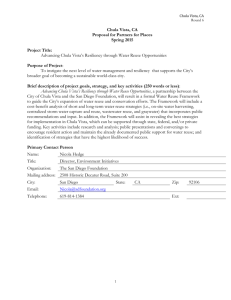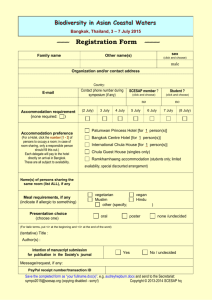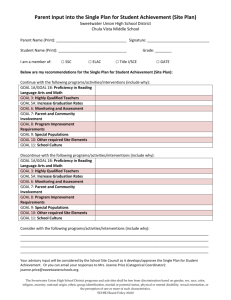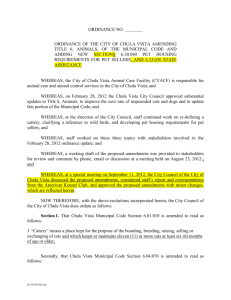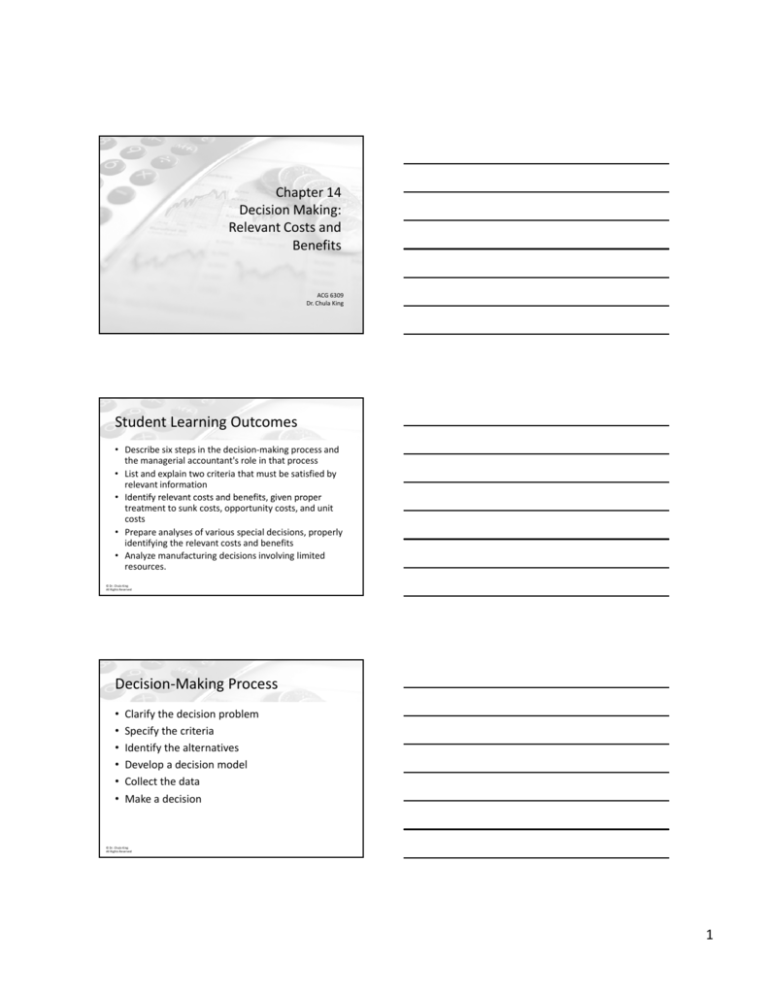
Chapter 14
Decision Making: Relevant Costs and Benefits
ACG 6309
Dr. Chula King
© Dr. Chula King
All Rights Reserved
Student Learning Outcomes
• Describe six steps in the decision‐making process and the managerial accountant's role in that process
• List and explain two criteria that must be satisfied by relevant information
• Identify relevant costs and benefits, given proper Identify relevant costs and benefits given proper
treatment to sunk costs, opportunity costs, and unit costs
• Prepare analyses of various special decisions, properly identifying the relevant costs and benefits
• Analyze manufacturing decisions involving limited resources. © Dr. Chula King
All Rights Reserved
Decision‐Making Process
•
•
•
•
•
•
Clarify the decision problem
Specify the criteria
Identify the alternatives
Develop a decision model
Collect the data
Make a decision
© Dr. Chula King
All Rights Reserved
1
Relevant Information
• Information has a bearing on the future
• Information differs among competing alternatives
© Dr. Chula King
All Rights Reserved
Identifying Relevant Costs and Benefits
• Sunk Costs ‐ Costs that have already been incurred in the past
• Opportunity Costs – The potential benefit given up when the choice of one action
given up when the choice of one action precludes selection of a different action.
© Dr. Chula King
All Rights Reserved
Analysis of Special Decisions
• A travel agency offers Worldwide Airways $150,000 for a round‐trip flight from Hawaii to Japan on a jumbo jet.
• Worldwide usually gets $250,000 in revenue yg $
,
from this flight.
• The airline is not currently planning to add any new routes and has two planes that are idle and could be used to meet the needs of the agency.
© Dr. Chula King
All Rights Reserved
2
Accept or Reject Special Order
Typical Flight Between Japan and Hawaii
Revenue:
Passenger
Cargo
$250,000
30,000
Total
$280,000
Expenses:
Variable expenses
$90,000
Allocated fixed expenses
100,000
Total
190,000
Profit
$90,000
Worldwide would save around $5,000 in reservation and ticketing costs if the charter is accepted.
© Dr. Chula King
All Rights Reserved
Excess Capacity
Special price for charter
Variable cost/flight
Reservation cost savings
Variable cost of charter
Contribution from charter
$150,000
$90,000
(5,000)
85,000
$65,000
Since the charter will contribute to fixed costs and Worldwide has idle capacity, the company should accept the flight.
© Dr. Chula King
All Rights Reserved
No Excess Capacity
• What if Worldwide had no excess capacity?
• If Worldwide adds the charter, it will have to cut its least profitable route that currently contributes $80 000 to fixed costs and profit
contributes $80,000 to fixed costs and profit.
• Should Worldwide still accept the charter?
© Dr. Chula King
All Rights Reserved
3
No Excess Capacity
Special price for charter
Variable cost/flight
$150,000
$90,000
Reservation cost savings
(5,000)
Variable cost of charter
$85,000
Opportunity cost:
Lost contribution on route
80,000
Total
165,000
Loss
$(15,000)
Worldwide has no excess capacity, so it should reject the special charter.
© Dr. Chula King
All Rights Reserved
Accept or Reject a Special Order
• With Excess Capacity: Relevant costs will usually be the variable costs associated with the special order
• Without Excess Capacity: Relevant costs will Without Excess Capacity: Relevant costs will
usually be both the variable costs associated with the special order, plus the opportunity costs of using the firm’s facilities for the special order.
© Dr. Chula King
All Rights Reserved
Outsouce a Product or Service
• Consider this: An Atlanta bakery has offered to supply the in‐flight desserts for Worldwide for $0.21 each.
Cost
Variable costs:
Variable
costs:
Direct material
$0.06
Direct labor
0.04
Variable overhead
0.04
Fixed costs:
Supervisory salaries 0.04
Equipment depreciation 0.07
Total cost/dessert
$0.25
Relevant
$0.06
0.04
0.04
0.01
‐0‐
$0.15
© Dr. Chula King
All Rights Reserved
4
Add or Drop a Service, Product or Department
• Consider this: Worldwide Airways offers its passengers the opportunity to join its World Express Club. Club membership entitles a traveler to use the club facilities in the Atlanta
traveler to use the club facilities in the Atlanta airport.
• Club privileges include a private lounge and restaurant, discounts on meals and beverages, and use of a small health spa.
© Dr. Chula King
All Rights Reserved
Add or Drop a Product
Keep Club Eliminate
Sales
$200,000
0
Food/Beverage
(70,000)
0
Personnel
(40,000)
0
Variable overhead
(25,000)
0
Contribution Margin 65,000
0
65 000
Depreciation
(30,000) (30,000)
Supervisor salary
(20,000)
0
Insurance
(10,000) (10,000)
Airport fees
( 5,000)
0
Allocated overhead (10,000) (10,000)
Loss
$ (10,000) $(50,000)
Differential
$200,000
(70,000)
(40,000)
(25,000)
65,000
65 000
0
(20,000)
0
( 5,000)
0
$ 40,000
© Dr. Chula King
All Rights Reserved
Add or Drop a Product ‐ Relevant
Keep Club Eliminate
Sales
$200,000
0
Food/Beverage
(70,000)
0
Personnel
(40,000)
0
Variable overhead
(25,000)
0
Contribution Margin 65,000
65 000
0
Avoidable fixed costs
Supervisor salary
(20,000)
0
Airport fees
( 5,000)
0
Profit/Loss
$ 40,000
Differential
$200,000
(70,000)
(40,000)
(25,000)
65 000
65,000
(20,000)
( 5,000)
$ 40,000
© Dr. Chula King
All Rights Reserved
5
Additional Analysis
Contribution margin from
general airline operations
that will be forgone if club
is eliminated . . . . . . . . . . . $ 60,000
Profit/Loss
fi /
$ 40,000
40 000
Monthly profit of
keeping the club open
–0–
–0–
0
$ 60,000
$ 40,000
40 000
$100,000
© Dr. Chula King
All Rights Reserved
Decisions Involving Limited Resources
• How should limited resources be used?
• Generally, fixed costs are not affected, so management can focus on maximizing total contribution margin
contribution margin.
© Dr. Chula King
All Rights Reserved
Consider This
Martin, Inc., produces two products. Selected data is shown below:
Products
Webs
Highs
Selling price/unit
$60
$50
Less: Variable expenses/unit
36
35
Contribution margin/unit
$24
$15
Current demand per week (units)
2,000
2,200
Contribution margin ratio
40%
30%
1.00 min.
0.50 min
Processing time required on the lathe/unit
The lathe is a scarce resource because there is excess capacity on other machines. The lathe is being used at 100% of its capacity, which is 2,400 minutes/week.
Should Martin focus its efforts on Webs or Highs?
© Dr. Chula King
All Rights Reserved
6
Contribution Margin/Minute
Products
Webs
Contribution margin/unit
Time required to produce one unit
Contribution margin/minute
Highs
$24
$15
÷ 1.00 min
÷ 0.50 min
$24/min
$30/min
Highs should be emphasized. It is the more valuable to use of the lathe which is a scarce resource. Highs yields a contribution margin of $30 per minute as opposed to $24 per minute for the Webs.
If there are no other considerations, the best plan would be to produce to meet the current demand for Highs and then use the remaining capacity, if any, to make Webs.
© Dr. Chula King
All Rights Reserved
Implementing the Plan
Weekly demand for Highs
Time required/unit
Time required to make Highs
Total lathe time available
Time available for Webs
Time required/unit
Production of Webs
2,200 units
x 0.50 minutes
1,100 minutes
2,400 minutes
1,300 minutes
x1.00 minute
1,300 units
© Dr. Chula King
All Rights Reserved
Limited Resources: Conclusion
Given the lathe capacity of 2,400 minutes, management should choose to make the current demand of 2,200 Highs per week, and 1,300 g p y
Webs with the remaining capacity.
Webs
Production and sales
1,300
Contribution margin/unit
x $24
Total contribution margin $31,200
Highs
2,200
x $15
$33,000
© Dr. Chula King
All Rights Reserved
7
Theory of Constraints
• Limit to a company’s profitability
• To relax constraints, managements could
– Outsource
– Work overtime
W k
i
– Retrain employees
– Reduce non‐value‐added activities
© Dr. Chula King
All Rights Reserved
Pitfalls to Avoid
•
•
•
•
Sunk costs
Opportunity costs
Allocated fixed costs
Unitized fixed costs
© Dr. Chula King
All Rights Reserved
The Next Step
• Exercises 14‐31, 14‐35, 14‐40
• Problems 14‐44, 14‐45, 14‐48, 14‐53, 14‐54
© Dr. Chula King
All Rights Reserved
8


